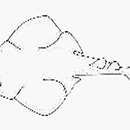en
names in breadcrumbs


Squatina Duméril , 1806 : 102, 342. Type Squalus squatina Linneaus 1758 , by subsequent designation.
Rhina Rafinesque 1810 : 4. Type Squalus squatina Linneaus 1758 , type by monotypy.
Definition. Broad, flattened body with large bat-like pectoral fins. Mouth terminal, broadly arched with ornate nasal flaps and highly protrusible jaws. Spiracles large, without valves. Pectoral fins not fused to head, origin opposite gill openings. Anterior extent of pectorals triangular and covering gill openings. Five pairs of gill openings positioned between pectoral origin and base of the head. Trunk compressed dorsal-ventrally. Two dorsal fins, spineless, originating behind pelvic fin insertion on the precaudal. Anal fin absent. Furrow on ventral from dorsal origin to caudal peduncle. Caudal fin hypocercal. Total length, depending on species, generally between 1-2 m.
Squatina Dumeril, 1806 is a monotypic genus within the family Squatinidae (Bonaparte, 1838). Although morphologically similar to batoids, squatinids are distinct from true batoids in that the squatinids have lateral gill openings, pectoral fin lobes that are free lateral to the gills, and possess a lower caudal fin lobe that is longer than the upper caudal lobe. Within the genus these sharks can be difficult to distinguish due to the lack of well defined characteristics. Adding to the confusion in the literature are the inadequate original descriptions of many species.
Sixteen valid species are recognized worldwide, with four reported to occur in the western North Pacific (WNP; Compagno et al., 2005). These four species include Squatina formosa Shen and Ting, 1972 , S. japonica Bleeker, 1858 , S. nebulosa Regan, 1906 , and S. tergocellatoides Chen, 1963 . Distinctions among these four WNP species hinge upon the nasal barbel shape, interorbital and interspiracle distances, ocellus patterns, number of dermal folds about the mouth, and the presence of midback thorns (Lindberg & Legeza, 1967; Shen & Ting, 1972; Nakabo, 2002). However, specific identification is hard to assign to individuals because many of these characters are difficult to distinguish, and many characters currently used are susceptible to damage during collection or from preservation. Additionally, inadequate original descriptions for some species and confusion within the subsequent literature have further obscured definitive characters among the WNP species. Because members of this genus are frequently targeted in fisheries in an area that has sparsely recorded catch information, and congeners are particularly sensitive to fishing pressure (Gaida, 1997; Stevens et al, 2000), it is imperative that adequate descriptions are available to identify individual species.
During two field expeditions to Taiwan, one of us (DAE) observed at least four species of Squatina that were frequently landed at fish markets around Taiwan. Attempts to identify the various species were often hampered by a lack of adequate fish keys and descriptive characters for the various Squatina species observed. Furthermore, we had the opportunity to examine the holotype and three paratypes of S. formosa as well as collect additional material.
Using this information, we provide a detailed redescription of three of the species, S. formosa , S. japonica , and S. nebulosa , with new material from Japanese and Taiwanese waters. In addition, we supply a list of important key characters for distinguishing all known WNP squatinids, especially to facilitate identification of the two most similar species, S. formosa and S. nebulosa .
The main confusion among WNP squatinids lies in differentiating S. formosa and S. nebulosa from one another. The main character used in the past to differentiate these two species was the number of dermal lobes at the corners of the mouth (Chen 1963, Nakabo 2002, Compagno 2005a). Based upon our examination, this character does not appear to be robust in separating these species. Although all S. formosa individuals studied had one dermal lobe, S. nebulosa specimens had one or two lobes, invalidating this character as a method of separating the two species. Additionally, the number of dermal lobes was often difficult to determine since differentiation between lobes is often vague and these lobes are susceptible to damage during capture and or preservation of specimens. A combination of characters should be used to identify individuals of these two species, since the differences are subtle and a great deal of overlap exists among many characters. The best characters available, based on our findings, appear to be the shape of the caudal pelvic and dorsal fins, the ratio of standardized pelvic girdle distance with the standardized head length, and the shape and height of the upper lip arch. The upper lip arch appears to be of particular value as a field character. It is a feature that is not prone to damage and is easy to assess quickly in the field. More specimens are needed to assess the utility of this character but it appears to be useful for all WNP squatinids.
Based on the key characters presented herein, we provide the following key to the WNP squatinids:
Key to Western North Pacific Squatina Species
1. Pelvic fin tips do not extend to origin of first dorsal fin..............................................................................2.
- Pelvic fin tips extend to or surpass origin of first dorsal fin........................................................................3.
2. A prominent row of thorn-like denticles extending from mid-back to caudal peduncle; no distinct ocelli on posterior lobes of the pectoral fins................................................................................................ S. japonica
- No row of thorn-like denticles extending from the mid-back to the caudal peduncle, distinct paired ocelli on the posterior lobes of the pectoral fins......................................................................... S. tergocellatoides
3. Upper lip arch semi-circular in shape (>1.5% TL in height); dorsals are lobed with a curvilinear anterior margin; pelvic girdle distance 1.4 times or less head length; caudal fin is lobed, especially dorsally, with a curvilinear postventral caudal margin........................................................................................... S. formosa
- Upper lip arch is not semi-circular in shape (<1.5% TL in height); dorsals are not lobed (angular) without a curvilinear anterior margin (straight); pelvic girdle distance greater than 1.4 times head length; caudal fin is not lobed (angular), especially dorsally, without a curvilinear postventral caudal margin (straight) ... ..................................................................................................................................................... S. nebulosa